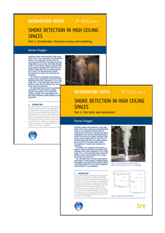Smoke detection in high ceiling spaces
BRE (Building Research Establishment) is an independent, research-based consultancy, testing and training organisation, operating in the built environment and associated industries. Smoke detection in high ceiling spaces is a two-part set of information papers written by R Chagger and published by BRE on 18 June 2012.
Specifying smoke detection for high-ceiling spaces is complicated, and the criteria for assessing the performance of aspirating and optical smoke detectors are generally not fully understood. Research by the BRE Trust and the Fire Industry Association (FIA), using computer modelling and full-scale tests, has enabled guidance to be revised. This Information Paper outlines the programme of research and summarises its conclusions.
It is aimed at manufacturers and installers of smoke detectors as well as building designers and regulators, helping them gain a full understanding of the factors influencing smoke detection in such applications.
The 12 page Part 1: Introduction, literature review and modelling, covers:
The 12-page Part 2: Fire tests and conclusions, covers:
- Introduction.
- Equipment details.
- Detector locations and configurations.
- Hangar conditions.
- Test fires.
- Results from the fire tests.
- Discussion.
- Conclusions from the fire tests.
- Conclusions.
- References.
[edit] Related articles on Designing Buildings Wiki
- BRE articles on Designing Buildings Wiki.
- BRE Buzz.
- BRE Buzz articles on Designing Buildings Wiki.
- BS 5839-1.
- Building Research Establishment.
- Domestic smoke alarms DG525.
- Fire detection and alarm system.
- Fire detector.
- Fire.
- Ionisation smoke alarm.
- Multi-sensor alarm.
- Optical smoke alarm.
- Smoke barrier.
- Smoke detector.
- The causes of false fire alarms in buildings.
Featured articles and news
Professional practical experience for Architects in training
The long process to transform the nature of education and professional practical experience in the Architecture profession following recent reports.
A people-first approach to retrofit
Moving away from the destructive paradigm of fabric-first.
International Electrician Day, 10 June 2025
Celebrating the role of electrical engineers from André-Marie Amperè, today and for the future.
New guide for clients launched at Houses of Parliament
'There has never been a more important time for clients to step up and ...ask the right questions'
The impact of recycled slate tiles
Innovation across the decades.
EPC changes for existing buildings
Changes and their context as the new RdSAP methodology comes into use from 15 June.
Skills England publishes Sector skills needs assessments
Priority areas relating to the built environment highlighted and described in brief.
BSRIA HVAC Market Watch - May 2025 Edition
Heat Pump Market Outlook: Policy, Performance & Refrigerant Trends for 2025–2028.
Committing to EDI in construction with CIOB
Built Environment professional bodies deepen commitment to EDI with two new signatories: CIAT and CICES.
Government Grenfell progress report at a glance
Line by line recomendation overview, with links to more details.
An engaging and lively review of his professional life.
Sustainable heating for listed buildings
A problem that needs to be approached intelligently.
50th Golden anniversary ECA Edmundson apprentice award
Deadline for entries has been extended to Friday 27 June, so don't miss out!
CIAT at the London Festival of Architecture
Designing for Everyone: Breaking Barriers in Inclusive Architecture.
Mixed reactions to apprenticeship and skills reform 2025
A 'welcome shift' for some and a 'backwards step' for others.























